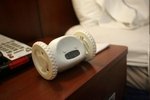In an interesting move, the Courtyard Newark (part of the Marriott brand) has created an “X-room” which contains the new hotel technologies and gadgets of the future. Its essentially a research project where new products for hotel rooms are trialled for 6-12 months with real guests before decisions are made about their inclusion into the main hotel offering.
You can book this room specifically or end up there by chance, but in exchange for you being able to try out these new toys, you need to fill out some survey information to help the research programme.
Some of the innovations they’ve been testing out in there include a universal battery charger, digital picture frame, touch-screen climate control and an intriguing one called “Clocky” – which is an alarm clock which runs away from you and screeches louder and louder if you don’t actually get out of bed. They have an electronic wine chiller and remote-controlled electronic candles. The showerhead being tested currently provides 70% stronger water pressure but uses 70% less water.
Whilst technology may not be that big a deal to many hotel chains, the whole idea of establishing a room as a “research lab” for new concepts isn’t a bad one.

corner so you have to get out of bed to turn it off



